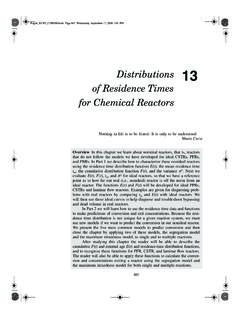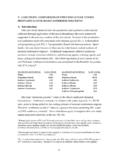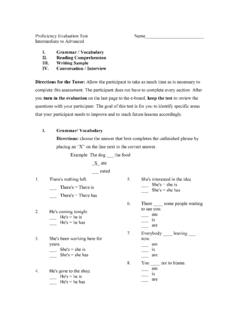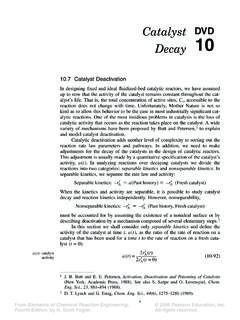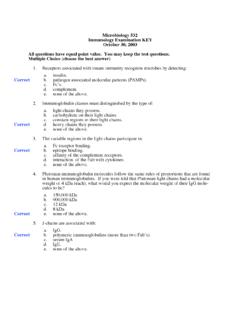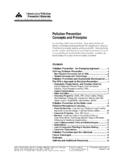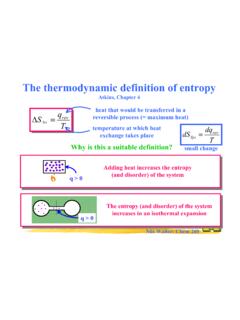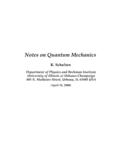Transcription of CHAPTER 12
1 CHAPTER 12 MOLECULAR SYMMETRYIn many cases, the symmetry of a molecule provides a greatdeal of information about its quantum states, even without adetailed solution of the Schr odinger equation. A geometricaltransformation which turns a molecule into an indistinguish-able copy of itself is called asymmetry operation. A symmetryoperation can consist of a rotation about an axis, a reflectionin a plane, an inversion through a point, or some combinationof Ammonia MoleculeWe shall introduce the concepts of symmetry and group theoryby considering a concrete example the ammonia molecule any symmetry operation on NH3, the nitrogen atom remainsfixed but the hydrogen atoms can be permuted in 3!
2 =6 differ-ent ways. The axis of the molecule is called a C3axis, sincethe molecule can be rotated about it into 3 equivalent orienta-tions, 120 apart. More generally, a Cnaxis has n equivalentorientations, separated by 2 /nradians. The axis of highestsymmetry in a molecule is called theprincipal axis. Threemirror planes, designated 1, 2, 3, run through the principalaxis in ammonia. These are designated as vorverticalplanesof symmetry . Ammonia belongs to the symmetry group desig-nated C3v, characterized by a three-fold axis with three verticalplanes of us designate the orientation of the three hydrogenatoms in Fig.
3 1 as{1,2,3}, reading in clockwise order fromthe bottom. A counterclockwise rotation by 120 , designated1C3H1H3H2 Figure views of the ammonia the operatorC3, produces the orientation{2,3,1}. A sec-ond counterclockwise rotation, designatedC23, produces gives{3,1,2}. Note that two successive counterclockwise rotationsby 120 is equivalent to one clockwise rotation by 120 , so thelast operation could also be designatedC 13. The three reflec-tion operations 1, 2, 3applied to the original configuration{1,2,3}produces{1,3,2},{3,2 ,1}and{2,1,3}, , we must include the identity operation, designatedE,which leaves an orientation unchanged.
4 The effects of the sixpossible operations of the symmetry group C3vcan be summa-rized as follows:E{1,2,3}={1,2,3}C3{1,2,3}={2,3,1 }C23{1,2,3}={3,1,2} 1{1,2,3}={1,3,2} 2{1,2,3}={3,2,1} 3{1,2,3}={2,1,3}We have thus accounted for all 6 posssible permutations of thethree hydrogen successive application of two symmetry operations isequivalent to some single symmetry operation. For example,applyingC3, then 1to our starting orientation, we have 1C3{1,2,3}= 1{2,3,1}={2,1,3}But this is eqivalent to the single operation 3. This can berepresented as an algebraic relation among symmetry operators 1C3= 3 Note that successive operations are applied in the orderrightto leftwhen represented algebraically.
5 For the same two oper-ations in reversed order, we findC3 1{1,2,3}=C3{1,3,2}={3,2,1}= 2{1,2,3}Thus symmetry operations donot, in general commuteA B6 B A(1)although theymaycommute, for example, algebra of the group C3vcan be summarized by thefollowing multiplication C3C23 1 2 32ndEE C3C23 1 2 3C3C3C23E 3 1 2C23C23E C3 2 3 1 1 1 2 3E C3C23 2 2 3 1C23E C3 3 3 1 2C3C23 ENotice that each operation occurs once and only once in eachrow and each TheoryIn mathematics, agroupis defined as a set ofgelementsG {G1, G2.. Gh}together with a rule for combination of ele-ments, which we usually refer to as aproduct.
6 The elementsmust fulfill the following four conditions.(i) The product of any two elements of the group is anotherelement of the group. That isGiGj=GkwithGk G(ii) Group multiplication obeys an associative law,Gi(GjGk) =(GiGj)Gk GiGjGk.(iii) There exists anidentity elementEsuch thatEGi=GiE=Gifor alli.(iv) Every elementGihas a unique inverseG 1i, such thatGiG 1i=G 1iGi=EwithG 1i number of elementshis called theorderof the C3vis a group of order set of quantities which obeys the group multiplicationtable is called arepresentationof the group.
7 Because of thepossible noncommutativity of group elements [cf. Eq (1)], sim-ple numbers are not always adequate to represent groups; wemust often use matrices. The group C3vhas threeirreduciblerepresentations, or IR s, which cannot be broken down intosimpler representations. A trivial, but nonetheless important,representation of any group is thetotally symmetric represen-tation, in which each group element is represented by 1. Themultiplication table then simply reiterates that 1 1 = 1. ForC3vthis is called the A1representation:A1:E= 1, C3= 1, C23= 1, 1= 1, 2= 1, 3= 1(2)A slightly less trivial representation is A2:A2:E= 1, C3= 1, C23= 1, 1= 1, 2= 1, 3= 1 (3)4 Much more exciting is the E representation, which requires 2 2matrices :E= 1 00 1 C3= 1/2 3/2 3/2 1/2 C23= 1/2 3/2 3/2 1/2 1= 1 001 2= 1/2 3/2 3/2 1/2 3= 1/2 3/2 3/2 1/2 (4)The operationsC3andC23are said to belong to the sameclasssince they perform the same geometric function, but fordifferent orientations in space.
8 Analogously, 1, 2and 3areobviously in the same class. E is in a class by itself. The classstructure of the group is designated by{E,2C3,3 v}. We statewithout proof that the number of irreducible representations ofa group is equal to the number of classes. Another importanttheorem states that the sum of the squares of the dimension-alities of the irreducible representations of a group adds up tothe order of the group. Thus, for C3v, we find 12+ 12+ 22= a matrix is defined as the sum ofthe elements along the main diagonal: (M) XkMkk(5)For many purposes, it suffices to know just the characters ofa matrix representation of a group, rather than the complete5matrices.
9 For example, the characters for the E representationof C3vin Eq (4) are given by (E) = 2, (C3) = 1, (C23) = 1, ( 1) = 0, ( 2) = 0, ( 3) = 0(6)It is true in general that the characters for all operations in thesame class are equal. Thus Eq (6) can be abbreviated to (E) = 2, (C3) = 1, ( v) = 0(7)For one-dimensional representations, such as A1and A2, thecharacters are equal to the matrices themselves, so Eqs (2) and(3) can be read as a table of essential information about a symmetry group is sum-marized in itscharacter table.
10 We display here the charactertable for C3vC3vE2C33 vA1111z z2, x2+y2A211 1E2 10 (x, y) (xy, x2 y2),(xz, yz)The last two columns show how the cartesian coordinatesx, y, zand their products transform under the operations of the Theory and Quantum MechanicsWhen a molecule has the symmetry of a groupG, this meansthat each member of the group commutes with the molecularHamiltonian[ Gi, H] = 0i= 1.. h(8)6where we now explicitly designate the group elementsGiasoperators on wavefunctions. As was shown in Chap. 4, com-muting operators can have simultaneous eigenfunctions.
